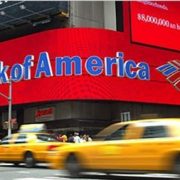As a potentially profitable opportunity presents itself, John will send you an alert with specific trade information as to what should be bought, when to buy it, and at what price. This is your chance to ?look over? John Thomas? shoulder as he gives you unparalleled insight on major world financial trends BEFORE they happen.
 Further Update to: Trade Alert -(BAC)
Further Update to: Trade Alert -(BAC)
Buy the Bank of America (BAC) March, 2014 $15-$16 bull call spread at $0.86 or best
Opening Trade
2-24-2014
expiration date: 3-21-2014
Portfolio weighting: 10%
Number of Contracts = 116 contracts
Bank of America (BAC) certainly was the chief whipping boy of the financial crisis. Since 2008, it has paid out more than $50 billion in fines and lawsuit settlements for every transgression under the sun.
After getting a bail out from the US Treasury, it was forced to cut its dividend payment to a token one cent. Do any Google search on the company and you are inundated with a flood of bad news.
All that is now ancient history. The entire banking industry is now moving into the sweet spot in the economic cycle. This is because rising interest rates mean that they will be able to charge more for leans, while their cost of funds (deposits and equity) remains low. This rising spread falls straight to the bottom line.
With the 30 year bull market in bonds now at an end, substantially higher rates in the near future are now included in virtually every economic forecast out there. Since the beginning of 2014 the ten-year Treasury yield has rocketed from 3.05% to as high as 2.58%, pummeling bank shares.
What happens next? They go from 2.58% back up to 3.05%, then a lot more. Bank shares will ride on the back of this bull.
The jungle telegraph is now ringing with the prospect of a dividend hike by the company, from a penny to five cents. The implications of such a move are broad.
For a start, the company would have to get the permission of the Federal Reserve to do so. If it pulls this off, it is only because of renewed confidence by the government in the improved financial condition of the country. After several capital raises and the liquidation of the wreckage of the 2008 crash, US banks are now the healthiest in history, with balance sheets of bedrock stability.
If (BAC) can get this first dividend hike through, more will follow. To get the dividend yield on the shares up to industry standard of 2.5%, the company really needs to raise its dividend to 40 cents. If certainly has the cash flow to do this. In 2013, (BAC) reported net income of $11.4 billion, more than four times to amount needed to cover such a payout.
Needless to say, this is all great news for the share price. The prospective return of increasing amounts of capital to shareholders should suck in new and wider classes of shareholders. It won't be just about hedge fund punters anymore.
Take a look at the charts below, and it is clear that such a move is setting up. (BAC) is reaching the end of a classic triangle formation, which traditionally resolves itself to the upside. You can find more dry powder in the chart for the Financials Select Sector SPDR ETF (XLF), which clearly rejected a complete breakdown at long term trend support in early February.
Finally, take a gander at the chart for the S&P 500. New life from the financials will be the adrenaline shot this market needs to break it out of its current low volume sideways consolidation, taking it to new highs.
This is why I popped out the trade alert to buy the (BAC) March $15-$16 call spread on Monday. Thanks to the denial of service attack on our email provider, AWeber Communications, it has taken me until now to get this update out.
It is all another reason to sign up for the Mad Hedge Fund Trader's text alert service, which readers around the world received within an incredible ten seconds of the original issue of the Trade Alert. I saw it work its magic when I was in Australia, and it is a sight to behold.
The best execution can be had by placing your bid for the entire spread in the middle market and waiting for the market to come to you. The difference between the bid and the offer on these deep in-the-money spread trades can be enormous. Don't execute the legs individually or you will end up losing much of your profit.
Keep in mind that these are ballpark prices only. Spread pricing can be very volatile on expiration months further out.
Here are the specific trades you need to execute this position:
Buy 116 March, 2014 (BAC) $15 calls at.............$1.64
Sell short 116 March, 2014 (BAC) $16 calls at.....$0.78
Net Cost:.......................................................$0.86
Potential Profit: $1.00 - $0.86 = $0.14
($0.14 X 100 X 116) = $1,624 - 1.62% for the notional $100,000 model portfolio





